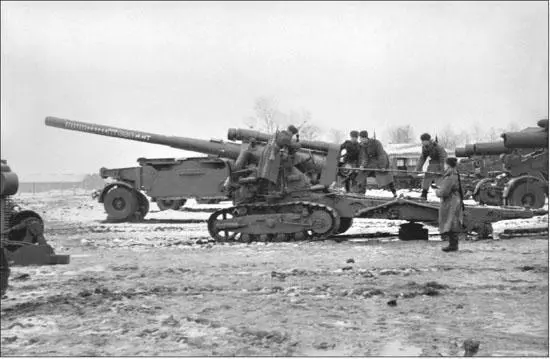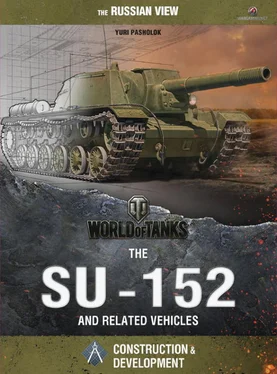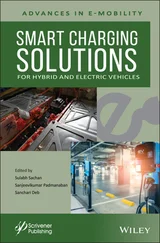- Machine-gun cartridges: 3000
- F-1 hand grenades: 30
- PPD cartridges: 1000
7. Mobility:
- Gradient: at least 40°
- Side slope: at least 30°
- Vertical step: at least 0.8 m
- Trench: at least 3.0 m
- Ground pressure: not more than 0.70 kg/cm²
- Ford (unprepared): at least 1.5 m
8. Fuel endurance: at least 10 hours of engine operation
9. Crew: 8
- Provide a capability for the crew to move around inside the vehicle (without exiting it).
Note: the installation and design of the gun must allow for firing at a 20° angle of depression.
10. Communications equipment:
- For external communication: a shortwave quartz radio and a set of flags
- For internal communication: an intercom system at four locations (commander, driver, gunner, radio operator)
- A rod antenna that can be lowered alongside the vehicle from the inside
11. Armor protection.
- Armor thickness:
— Glacis: 75 mm
— Side: 60 mm
— Turret: 60 mm
— Roof: 30 mm
— Bottom: 40 and 30 mm
- The armor must be sloped at least 20°.
12. Engine: V-2K diesel engine supercharged to 850 hp.
13. Observation and aiming devices.
- In the turret, a PT-1 from the 45 mm tank gun and a new 6x telescopic sight with a 6–11° field of view.
- Mount a cupola for the commander with 360° visibility on the vehicle roof.
- Vision blocks with mirrors may be used.
- Provide the driver-mechanic with a vision block for forward vision and an optical device with a mirror in the vehicle roof for observation to the sides.
- Provide a vision block with a mirror for the radio operator.
- All vision devices must be designed to prevent projectiles, bullets, lead spray, and burning liquid from entering the tank through them.
- Provision must be made for replacing vision devices, their heads and lenses, and the crew must be able to safely clean them from inside the vehicle.
14. Special equipment:
a) The driver’s position must be designed for maximum comfort when driving the vehicle.
b) Locate the instrumentation for easy visibility by the driver and keep it to a minimum.
c) Provide protection for the driver against wind, dust, and rain when driving with the hatch open.
d) Use KV-type seats for the driver, radio operator, and all turret seats.
e) Power steering may be installed to facilitate driving.
f) Provide for cleaning and heating the air in the fighting and driving compartments.
g) Provide a gyrocompass for the driver.
h) Develop tools for facilitating the mounting of tracks, for removing the main assemblies and armor from the hull, and for self-recovery of the vehicle.
i) Develop a simple hoist for projectiles. {4} 4 TsAMO RF, collection 81, series 12104, file No. 147, pp. 47–49.

BR-2 152 mm gun mod. 1945. This gun, which could penetrate a concrete wall up to 2 meters thick, was the highest priority armament for future bunker busters (YuP).
The SP gun that the Kirov Factory was tasked to develop was assigned the factory designation 212 (it has often been called Object 212). The lead designer on the SP gun project was Ts. N. Golburt. This was the second vehicle with the same designation: a recovery vehicle based on the KV chassis had also developed under the designation 212. Therefore, the SP gun was often referred to as the 212A. Self-propelled gun 212 resembled an up-armored SU-14-1, especially in the arrangement of its fighting compartment. The chassis of the 212 was a reworked 220 (T-220) chassis with the engine compartment located in the center of the vehicle and the transmission and drive wheels in the front. The driver’s compartment was located in the bow, with only enough space for the driver-mechanic. The fighting compartment was located in a large superstructure at the rear of the vehicle. On the one hand, this design significantly increased the vehicle’s overall size; on the other hand, it improved crew comfort. In addition, placement of the superstructure at the rear made it possible to reduce the extent to which the BR-2 152 mm gun extended beyond the vehicle.
The sum allocated for development of the 212 was 2 million rubles. Of that amount, 100,000 rubles went for development of the engineering design; 25,000 for constructing the mockup; 300,000 for drawings; 75,000 for revising the drawings; 1,100,000 for manufacturing a prototype; 100,000 for testing; and 300,000 for maintenance. That figure did not include the cost of armament.
Plans called for manufacturing the SP gun prototype by December 1, 1940. However, it became necessary to make major adjustments to the plan. On December 10, 1940, the GAU’s Artillery Committee received a letter from the Kirov Factory signed by Zh. Ya. Kotin, head of SKB-2; P. F. Fedorov, head of SKB-4; and Ts. N. Golburt, the system’s chief designer. The letter contained a large number of comments on the operational requirement concerning issues that had arisen during design of the SP gun:
I. The vehicle weight of 55 tonnes stipulated in the operational requirement cannot be met with the armor specified for the following reasons:
1) The operational requirement states that the vehicle must be designed using the KV chassis and powertrain. The weight of these components, which totals 17,400 kg (excluding the engine with its fuel and cooling systems), cannot be reduced.
2) As installed on the vehicle, the BR-2 and its ammunition package weigh 17,600 kg.
3) The machine guns, ammunition, observation turret, seating, radio, fuel, crew, spare tools and accessories kit, etc., weigh 3000 kg.
4) Therefore, if the vehicle is to weigh 55,000 kg, the weight of the hull with (fixed) turret must be 17,000 kg.
The large size of the system results in the following hull dimensions:
Length: 7900 mm, width: 1920 mm, and height to top of turret: 2570 mm (from the bottom of the vehicle).
A weight of 17,000 kg is clearly not feasible for a hull of that size.
The size of the hull cannot be further reduced.
The hull of the SMK-1 may be taken as an example of a hull of similar size. Fitted with 60 mm of armor (side, glacis, turret), a bottom thickness of 30 and 20, and a roof thickness of 30, it weighed 31 tonnes (with turrets).
The armor thicknesses listed in the operational requirement are as follows:
- Glacis: 75 mm
- Side: 60 mm
- Turret: 60 mm
- Top: 30 mm
- Bottom: 40 and 30 mm
It is impossible to design a vehicle weighing 55 tonnes with a hull and turret weighing a total of 17 tonnes.
Our design is armored as follows:
- Side: 60 mm
- Glacis: 60 mm (slope: 30°)
- Lower front plate: 50 mm (slope: 45°)
- Lower rear plate: 50 mm (slope: 40°)
- Turret: 60 mm (slope: 10°)
- Bottom front: 30 mm
- Bottom rear: 20 mm
- Top: 20 mm
The weight of the vehicle without fuel, ammunition, and crew is 60 tonnes.
The combat weight of the vehicle is 65 tonnes.
At a weight of 65 tonnes, its ground pressure without armament is 0.83 kg/cm².
II. 1. In comparison with the BR-2 field gun, the laying rate is reduced by 33% in elevation and 10% in traverse.
The efforts required to operate the hand wheels are as follows: elevation: up to 10 kg; traverse: up to 8 kg.
2. The current recuperator mechanism design does not support firing at a depression angle of 3°.
3. The traverse angle is 4°, the same as the original field gun.
4. The combat load consists of 47 projectiles. There is no projectile hoist; there is a loading tray similar to the M-10 on the KV.
Читать дальше













